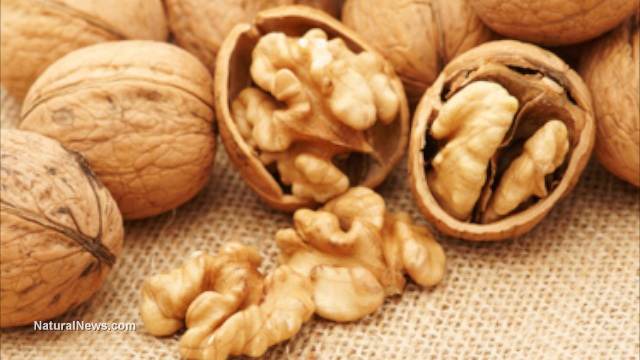
Advertisement
While their wrinkled, brain-like appearance may be far from appetizing, walnuts boast the highest levels of antioxidants out of all nuts. What’s more, the antioxidants in walnuts are two to 15 times more potent than vitamin E, which is renowned for its powerful antioxidant properties.
Moreover, these formidable tree nuts are brimming with health-promoting omega-3 fats, as well as essential nutrients like copper, manganese and biotin. Walnuts’ plant-based protein is also a decent substitute for protein in animal meat and fish. You’d be nuts to ignore walnuts!
Health benefits
Eating walnuts can provide a wide range of health benefits when added to a balanced diet. These include:
- Fights inflammation – Inflammation that persists for long periods is at the root of most chronic diseases. The good news is that walnuts are rich in plant compounds that are capable of reducing and eliminating inflammation for good. These include ellagitannins, omega-3 fats and the amino acid arginine.
- Prevents weight gain – With their high-calorie content, walnuts don’t necessarily scream “diet food” for most health-conscious consumers. But new research shows that walnuts can prevent weight gain because of their effect on appetite. More importantly, you don’t even have to eat bowlfuls of walnuts to reap this benefit!
- Reduces diabetes risk – Omega-3 fats in walnuts take center stage when it comes to diabetes prevention and management. This is because omega-3 fats are associated with a reduced risk of developing diabetes in the first place. Walnuts can also prevent the development of serious complications in people with diabetes.
- Improves brain health – While it might just be pure coincidence that walnuts look like brains, there is some evidence that walnuts can, in fact, boost overall brain health. For instance, Spanish researchers found that eating more than one serving of walnuts per week was associated with improvements in overall cognition and healthier aging of the brain.
- Supports healthy aging – Experts find that nutrient-rich foods like walnuts can help us age better and help prevent physical impairments that affect our quality of life.
- Lowers blood pressure – The fiber, antioxidants and omega-3 fats in walnuts all work to lower resting blood pressure and high blood pressure, a major risk factor for heart disease. Studies also show that eating walnuts can bring down blood pressure levels in people under stress.
- Reduces bad cholesterol – Thanks to alpha-linolenic acid, walnuts are also capable of reducing levels of bad cholesterol. This kind of cholesterol is notorious for clogging arteries and raising the risk of heart disease and its complications.
- Prevents certain cancers – Emerging research suggests that ellagitannins, the antioxidants that help fight inflammation, could also be instrumental in preventing the onset of several cancers, including those of the breast, prostate and colon.
- Promotes good gut health – Trillions of bacteria, both good and bad, live in our gastrointestinal tract, and the foods we eat dictate how those bacteria benefit or affect our gut health. Walnuts, for instance, have been shown to have a positive effect on gut bacteria because of their high fiber content. In the long run, this could translate to better protection against disease.
- Boosts reproductive health – Several studies also suggest that walnuts can boost reproductive health in men. One clinical trial showed that men who ate walnuts as part of their regular diet for three months had higher sperm counts. Moreover, animal-based research suggests that eating walnuts can help protect sperm from oxidative stress that could damage its genetic material.
Recipes
Walnuts are a versatile food. Eat them as-is for a delicious and filling snack or sprinkle them over salads and side dishes. Even better, whip up these walnut recipes for nuttier pastries, breads, sauces, snack poppers and more!
Banana and walnut bread
This wholesome bread is light and moist, with the natural sweetness of bananas and the warm earthiness of walnuts.
Ingredients:
- 2 large eggs
- 1 1/4 cups all-purpose flour
- 1 cup mashed ripe bananas
- 1 cup sugar
- 1/2 cup toasted walnuts
- 1/2 cup unsalted butter
- 1 teaspoon baking soda
- 1/2 teaspoon fine salt
Preparation:
- Preheat the oven to 350 F. Brush a loaf pan with just enough butter.
- In a medium bowl, sift the flour, baking soda and salt. Set aside.
- In another bowl, whisk the eggs and vanilla extract. Set aside.
- Using a mixer, cream the butter and sugar until light.
- Pour the egg mixture into the butter and mix.
- Add the mashed bananas and mix again.
- Fold in the flour mixture, then add the walnuts.
- Transfer the batter into the pan. Bake for 55 minutes.
- Let the bread cool for at least 5 minutes before serving.
Date and walnut cinnamon bites
Making delicious and nutritious snacks doesn’t get easier than these dates and walnut cinnamon bites. You can also serve them as an appetizer or prepare a batch for office snacking.
Ingredients:
- 3 walnut halves
- 3 pitted Medjool dates
- Ground cinnamon, to taste
Preparation:
- Cut each walnut half into three slices. Do the same with the dates.
- Place a slice of walnut on top of each date slice.
- Dust with cinnamon to taste and serve.
Roasted cauliflower and walnut dip
Skip the processed spreads and make one yourself! This roasted cauliflower and walnut dip goes well with homemade pastries and biscuits. You can also pair it with raw veggie sticks for a light and flavorful snack brimming with nutrients.
Ingredients:
- 1 head garlic
- 4 cups cauliflower florets
- 1 cup walnuts, presoaked
- 1/2 cup water
- 1/4 cup walnut oil
- 2 tablespoons lemon juice
- 4 teaspoons olive oil, divided
- 1 teaspoon minced rosemary
- 3/4 teaspoon salt, divided
- 1 pinch ground black pepper
- Toasted, chopped walnuts
Preparation:
- Preheat the oven to 400 F.
- Place the cauliflower florets on a baking sheet and drizzle with 3 teaspoons olive oil and 1/2 teaspoon salt.
- Cut off the tip of the garlic head to expose the cloves. Drizzle with 1 teaspoon olive oil and 1/8 teaspoon salt.
- Wrap the cauliflower florets and garlic in foil, then place them back on the baking sheet.
- Roast for 35–40 minutes or until tender, then let cool on the baking sheet for 5 minutes.
- Peel the garlic cloves, then toss them into a food processor along with the florets.
- Drain the presoaked walnuts and add them to the food processor.
- Pour in 1/2 cup water, walnut oil, lemon juice, rosemary and 1/8 teaspoon salt.
- Puree the ingredients until smooth, adding more water if needed.
- Transfer the dip into a bowl. Top with pepper and toasted walnuts.
While most nuts can be considered nutritious, walnuts stand out because of their health-promoting fats and antioxidants. For healthier snacking, swap walnuts for chips and sweets, or whip up some of the delicious walnut recipes listed above.
Sources:
Advertisements







